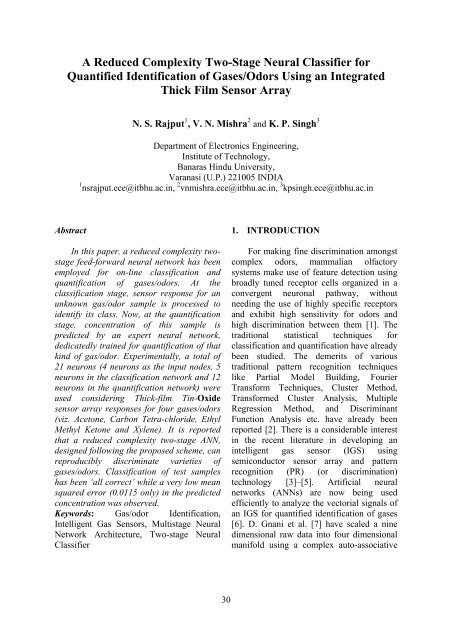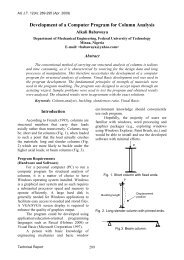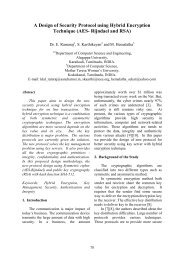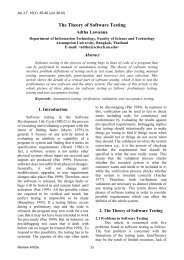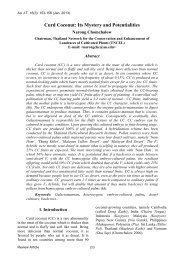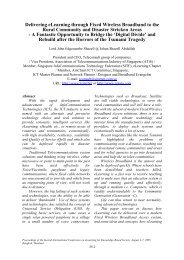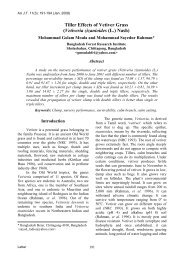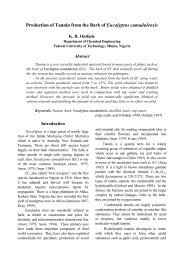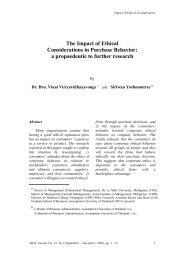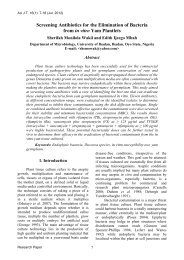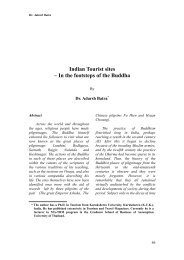A Reduced Complexity Two-Stage Neural Classifier for ... - AU Journal
A Reduced Complexity Two-Stage Neural Classifier for ... - AU Journal
A Reduced Complexity Two-Stage Neural Classifier for ... - AU Journal
You also want an ePaper? Increase the reach of your titles
YUMPU automatically turns print PDFs into web optimized ePapers that Google loves.
A <strong>Reduced</strong> <strong>Complexity</strong> <strong>Two</strong>-<strong>Stage</strong> <strong>Neural</strong> <strong>Classifier</strong> <strong>for</strong><br />
Quantified Identification of Gases/Odors Using an Integrated<br />
Thick Film Sensor Array<br />
N. S. Rajput 1 , V. N. Mishra 2 and K. P. Singh 3<br />
Department of Electronics Engineering,<br />
Institute of Technology,<br />
Banaras Hindu University,<br />
Varanasi (U.P.) 221005 INDIA<br />
1 nsrajput.ece@itbhu.ac.in, 2 vnmishra.ece@itbhu.ac.in, 3 kpsingh.ece@itbhu.ac.in<br />
Abstract<br />
In this paper, a reduced complexity twostage<br />
feed-<strong>for</strong>ward neural network has been<br />
employed <strong>for</strong> on-line classification and<br />
quantification of gases/odors. At the<br />
classification stage, sensor response <strong>for</strong> an<br />
unknown gas/odor sample is processed to<br />
identify its class. Now, at the quantification<br />
stage, concentration of this sample is<br />
predicted by an expert neural network,<br />
dedicatedly trained <strong>for</strong> quantification of that<br />
kind of gas/odor. Experimentally, a total of<br />
21 neurons (4 neurons as the input nodes, 5<br />
neurons in the classification network and 12<br />
neurons in the quantification network) were<br />
used considering Thick-film Tin-Oxide<br />
sensor array responses <strong>for</strong> four gases/odors<br />
(viz. Acetone, Carbon Tetra-chloride, Ethyl<br />
Methyl Ketone and Xylene). It is reported<br />
that a reduced complexity two-stage ANN,<br />
designed following the proposed scheme, can<br />
reproducibly discriminate varieties of<br />
gases/odors. Classification of test samples<br />
has been ‘all correct’ while a very low mean<br />
squared error (0.0115 only) in the predicted<br />
concentration was observed.<br />
Keywords: Gas/odor Identification,<br />
Intelligent Gas Sensors, Multistage <strong>Neural</strong><br />
Network Architecture, <strong>Two</strong>-stage <strong>Neural</strong><br />
<strong>Classifier</strong><br />
1. INTRODUCTION<br />
For making fine discrimination amongst<br />
complex odors, mammalian olfactory<br />
systems make use of feature detection using<br />
broadly tuned receptor cells organized in a<br />
convergent neuronal pathway, without<br />
needing the use of highly specific receptors<br />
and exhibit high sensitivity <strong>for</strong> odors and<br />
high discrimination between them [1]. The<br />
traditional statistical techniques <strong>for</strong><br />
classification and quantification have already<br />
been studied. The demerits of various<br />
traditional pattern recognition techniques<br />
like Partial Model Building, Fourier<br />
Trans<strong>for</strong>m Techniques, Cluster Method,<br />
Trans<strong>for</strong>med Cluster Analysis, Multiple<br />
Regression Method, and Discriminant<br />
Function Analysis etc. have already been<br />
reported [2]. There is a considerable interest<br />
in the recent literature in developing an<br />
intelligent gas sensor (IGS) using<br />
semiconductor sensor array and pattern<br />
recognition (PR) (or discrimination)<br />
technology [3]–[5]. Artificial neural<br />
networks (ANNs) are now being used<br />
efficiently to analyze the vectorial signals of<br />
an IGS <strong>for</strong> quantified identification of gases<br />
[6]. D. Gnani et al. [7] have scaled a nine<br />
dimensional raw data into four dimensional<br />
manifold using a complex auto-associative<br />
30
A <strong>Reduced</strong> <strong>Complexity</strong> <strong>Two</strong>-<strong>Stage</strong> <strong>Neural</strong> <strong>Classifier</strong> <strong>for</strong> Quantified<br />
Identification of Gases/Odors Using an Integrated Thick Film Sensor Array<br />
neural network comprising of 42 neurons in<br />
five layers, gaining better per<strong>for</strong>mance than<br />
respective principal component analysis<br />
(PCA) and projection pursuit network (PPN)<br />
methods <strong>for</strong> data in<strong>for</strong>mation compaction,<br />
and they finally trained a neural network <strong>for</strong><br />
IGS using second-order scaled conjugate<br />
gradient (SCG) method and refined through<br />
vanilla back-propagation algorithm. M.<br />
Pardo et al. [8] have gained enhancement<br />
through data pre-processing <strong>for</strong> classification<br />
of different brands of Espresso coffee with<br />
an electronic nose using PCA, up to 87.5%<br />
of classification per<strong>for</strong>mance, being the best<br />
than using Self Organizing maps (SOM). T.<br />
Roppel et al. [9] have established that data<br />
pre-processing using pulse coupled neural<br />
network (PCNN), rank order filtering (ROF)<br />
and centroid proximity metric (CPM) outper<strong>for</strong>ms<br />
principal component analysis<br />
(PCA) <strong>for</strong> data pre-processing <strong>for</strong> neural<br />
quantifier in succeeding stage and have<br />
compared respective improvement in<br />
concentration identification up to 96% of<br />
correct identification. This is also<br />
recommended that while classifying a data,<br />
the process of classification be divided in<br />
two steps: super-class and sub-class, and<br />
then the super-class should be explored and<br />
this approach has been quoted as the ‘spirit<br />
of hierarchical classification' [10], [11].<br />
Better generalization ability of a two-stage<br />
network has also been utilized by Henkel et<br />
al. [12] <strong>for</strong> monitoring carbon dioxide and<br />
relative humidity but with step quantification<br />
<strong>for</strong> relative humidity in seven classes (from 0<br />
to 60%) and gradual quantification of CO2<br />
from 0 to 650 ppm facing variety of<br />
constraints and processed the data set <strong>for</strong><br />
each stage with discordant reservations.<br />
In recent literature, Acetone, Carbon<br />
Tetra-chloride, Ethyl Methyl Ketone and<br />
Xylene have been shown to score high<br />
hazard rankings among major industrial<br />
pollutants, considering its toxicity,<br />
persistence and exposure potential, evaluated<br />
through many parameters like Worker<br />
Exposure Hazard, Human Health Effect,<br />
Environmental Hazard Value and Total<br />
Hazard Value Score. Thereby, the need of<br />
accurately identified quantification of these<br />
gases using minimal complexity networks<br />
has gained importance <strong>for</strong> the development<br />
of real-time high-speed IGS <strong>for</strong> its use in<br />
hazard prone industrial situations [13] – [16].<br />
Considering various aspects of<br />
previously published literature, and human<br />
and ecological health ranking of a<strong>for</strong>esaid<br />
industrial pollutants, we are motivated to<br />
attempt an n-stage neural network to achieve<br />
higher degree of quantified identification of<br />
the gases/odors with much simpler network<br />
architecture, involving only a few neurons<br />
and layers.<br />
2. THE EXPERIMENT<br />
To take up an experiment over the<br />
concept of effectiveness in ‘reducedcomplexity<br />
over convergent neuronal<br />
pathway’, an n-stage neural network <strong>for</strong><br />
quantified identification of individual<br />
gas/odor is considered. We have utilized the<br />
responses of sensor array <strong>for</strong> Acetone,<br />
Carbon Tetra-chloride, Ethyl Methyl Ketone<br />
and Xylene, as reported by Nayak et al. [17].<br />
The sensor used in their experiments<br />
consisted of an array of four sensors with an<br />
integrated heater on a substrate. Four<br />
different sensors <strong>for</strong>ming an array were<br />
fabricated with SnO2 as a base material and<br />
doped with different materials, namely, ZnO<br />
(sensor A), undoped SnO2 (sensor B), MoO<br />
(sensor C) and CdS (sensor D). The sensor<br />
array was fabricated using thick film<br />
technology. The fabrication process is<br />
described in detail in reference [17]. The test<br />
rig used to collect sensor array response data<br />
and experimental conditions in the laboratory<br />
have also been described in the above<br />
reference. The four gases/odors used in the<br />
referred experiment are Acetone (ace), Ethyl<br />
Methyl Ketone (emk), Carbon Tetra-chloride<br />
International <strong>Journal</strong> of the Computer, the Internet and Management Vol.18.No.3 (September - December, 2010) pp 30-37<br />
31
N. S. Rajput, V. N. Mishra, and K. P. Singh<br />
(car) and Xylene (xyl) and the outputs<br />
measured were percent change in resistance<br />
of different sensors when exposed to various<br />
concentrations of these gases. As mentioned<br />
earlier, data used in the present analyses are<br />
derived from the results of [17], there<strong>for</strong>e,<br />
the sensor characteristics from [17] have<br />
been reproduced here <strong>for</strong> ready reference in<br />
Figure 1(a) to 1(d).<br />
Using ‘Precision Image Digitizer ver.<br />
1.3.0.0’, the graphs of Fig. 1(a). to 1(d). were<br />
imported and three categories of data were<br />
generated viz. Data set I (with 8 vectors <strong>for</strong><br />
ace, 10 vectors <strong>for</strong> car, 12 vectors <strong>for</strong> emk<br />
and 12 vectors <strong>for</strong> xyl), Data set II (with 8<br />
vectors <strong>for</strong> ace, 9 vectors <strong>for</strong> car, 7 vectors<br />
<strong>for</strong> emk and 8 vectors <strong>for</strong> xyl) and Data set<br />
III (with 3 vectors <strong>for</strong> ace, 4 vectors <strong>for</strong> car,<br />
6 vectors <strong>for</strong> emk and 5 vectors <strong>for</strong> xyl). All<br />
of these vectors were uncorrelated and were<br />
generally uni<strong>for</strong>mly spaced all over the<br />
concentration axis of the graphs at Figs. 1(a).<br />
to 1(d). From raw data, normalized data<br />
were developed by shifting the origin to<br />
match the graph’s origin and the data were<br />
scaled over the axes ranges of the graph, as<br />
the data points were in terms of respective<br />
pixel values of the software window. For all<br />
data points and graph windows, origin<br />
shifting and axes scaling was carried through<br />
(1), (2) and (3),<br />
… (1),<br />
Here, <strong>for</strong> all data pixels, is the true pixel<br />
coordinate w.r.t. the origin of the respective<br />
graph, is the pixel coordinate w.r.t.<br />
the origin of the software window where the<br />
graph is imported and , is the<br />
origin of the actual graph while is<br />
always the origin of the window where the<br />
graph is imported <strong>for</strong> digitization.<br />
are the true<br />
maximum values of x-axis pixel and y-axis<br />
pixel, respectively.<br />
and are the<br />
represented as maximum ranges of<br />
percentage concentration along the x-axis<br />
and the maximum percentage change in<br />
resistance represented along the y-axis,<br />
respectively; taken appropriately <strong>for</strong> each<br />
gas/odor. and is<br />
the concentration of a particular gas/odor and<br />
the percentage change of sensor element<br />
resistance <strong>for</strong> the data point of the graph,<br />
plotted along x-axis and y-axis <strong>for</strong> each<br />
gas/odor and <strong>for</strong> each sensor element<br />
individually.<br />
The normalized ‘sensor response vs. gas<br />
concentration’ data was hence intrinsically<br />
obtained <strong>for</strong> all the four gases/odors viz. ace,<br />
car, emk and xyl. These data were used <strong>for</strong><br />
training and testing of the neural network<br />
thus conceived.<br />
3. THE CONCEPT ANN<br />
and<br />
… (2)<br />
… (3).<br />
Inspired by the general architecture of<br />
Mammalian Olfactory System [1] and<br />
following the principles of odor coding [18]<br />
and the spirit of hierarchical classification<br />
[11], we divided the task of classified<br />
quantification into a two stage task wherein<br />
first stage should classify the data into its<br />
classes. Thence, the duly classified data from<br />
individual class should be quantified using<br />
respective quantifier trained <strong>for</strong> that class and<br />
the neural net used <strong>for</strong> this should be of<br />
simplest configuration in terms of perceptron<br />
32
A <strong>Reduced</strong> <strong>Complexity</strong> <strong>Two</strong>-<strong>Stage</strong> <strong>Neural</strong> <strong>Classifier</strong> <strong>for</strong> Quantified<br />
Identification of Gases/Odors Using an Integrated Thick Film Sensor Array<br />
Accordingly, Mean Square Error (mse)<br />
is taken to be the per<strong>for</strong>mance parameter as<br />
it is the average of squared error between the<br />
network output vectors and the targeted<br />
output vectors . The mse is calculated<br />
as below:<br />
… (4).<br />
standard numerical optimization technique<br />
[20] to approach second-order training<br />
speed without having to compute the Hessian<br />
matrix [21].<br />
4. THE CLASSIFYING NETWORK<br />
The neural network was planned in twostages,<br />
first of which was to classify data into<br />
the known categories of gases/odors (4 as in<br />
our case). A two-layer minimal-complexity<br />
neural classifier with only four neurons (viz.<br />
5, 6, 7 and 8) with Hyperbolic Tan-sigmoid<br />
function in the hidden layer and only one<br />
neuron (viz. 9) with Linear function in the<br />
output layer is shown in Fig. 2.<br />
Fig. 2. <strong>Classifier</strong>.<br />
Here, is the total number of input<br />
vectors used in training /testing, while is the<br />
nth training pattern. ‘mse’ is especially<br />
chosen as the per<strong>for</strong>mance parameter since<br />
this per<strong>for</strong>mance index is a quadratic<br />
function and will either have one global<br />
minimum or a weak minimum or even, no<br />
minimum, depending on the characteristics<br />
of the input vectors [19]. The gradient of the<br />
per<strong>for</strong>mance function should be used to<br />
determine the way to adjust the weights to<br />
minimize per<strong>for</strong>mance function and the<br />
weights are moved in the direction of the<br />
negative gradient, through the chain rule of<br />
calculus. Iteration used in this algorithm is<br />
written as :<br />
… (5),<br />
where, is a vector of current weights<br />
and biases, is the current gradient, and<br />
is the learning rate. For straight<strong>for</strong>ward<br />
convergence, gradient descent is chosen and,<br />
is implemented in batch mode. Simpler yet<br />
faster training of the neural network is<br />
achieved using LM algorithm utilizing<br />
Fig. 3. <strong>Classifier</strong>’s per<strong>for</strong>mance over test data.<br />
Data set I and Data set II were used to<br />
train the a<strong>for</strong>esaid classifier <strong>for</strong> known<br />
classes of gas/odor using LM algorithm with<br />
per<strong>for</strong>mance function as mse and the input<br />
vectors were taken without any modification<br />
as were obtained in sec. 4. Weights and<br />
biases of the classifier network were<br />
initialized with random numbers between 0<br />
and 1 <strong>for</strong> 100 epochs with mse goal to be<br />
0.0001. For early stopping minimum<br />
gradient was chosen to be , else<br />
International <strong>Journal</strong> of the Computer, the Internet and Management Vol.18.No.3 (September - December, 2010) pp 30-37<br />
33
N. S. Rajput, V. N. Mishra, and K. P. Singh<br />
optimally trained set of weights and biases<br />
was obtained when the weight and bias<br />
update starts to raise mse in five successive<br />
iterations. The parameter was initialized<br />
with a value of 0.001, which was<br />
incremented or decremented by multiplying<br />
with 10 or 0.1, respectively, up to a<br />
maximum of . The Learning rate as in<br />
(5), is multiplied with the negative of the<br />
gradient to determine the changes to the<br />
weights and biases. For this network, when<br />
the minimum gradient of update descent is<br />
reached, the training stops. Optimality of<br />
weights and biases is the condition <strong>for</strong> early<br />
stopping, subject to, if the error in successive<br />
iterations typically begins to rise, <strong>for</strong> a<br />
predefined number of iterations (five, as<br />
described earlier) and the set of weights and<br />
biases at the minimum of the error is<br />
retained. As previously described, the<br />
network is trained with LM algorithm [20].<br />
In here, we have initialized the<br />
parameter with a value of 0.001. It is<br />
multiplied by 0.1, whenever the per<strong>for</strong>mance<br />
function is reduced by a step whereas It is<br />
multiplied by 10, whenever a step would<br />
increase the per<strong>for</strong>mance function. When<br />
becomes larger than the training is<br />
Fig. 4. Quantifier structure used <strong>for</strong><br />
each class of gas/odor.<br />
stopped.<br />
Once, the network was trained, it was<br />
exported and named as <strong>Classifier</strong>_1.<br />
Multiples of such classifiers were created<br />
taking variety of training and learning<br />
criteria and each classifier was tested with<br />
the data set III <strong>for</strong> better per<strong>for</strong>mance. It has<br />
been observed that <strong>for</strong> the best per<strong>for</strong>ming<br />
classifier, the classifier could be trained in<br />
just 18 epochs giving 100% accurate<br />
per<strong>for</strong>mance <strong>for</strong> the data set III (consisting of<br />
18 samples) when used as test data (Figure<br />
3).<br />
5. THE QUATNIFYING NETWORK<br />
Once input data vectors were identified<br />
to be associated with a specific class of<br />
gas/odor, we attempted to quantify the<br />
concentration of that gas/odor through its<br />
neural quantifier. As the data had already<br />
been associated with its respective gas/odor,<br />
individual quantifiers <strong>for</strong> specific gas/odor<br />
were, then, designed with a two-layer<br />
minimal-complexity neural net involving<br />
only two neurons with Hyperbolic Tansigmoid<br />
function in the hidden layer and<br />
only one neuron with Linear function in the<br />
output layer [25] <strong>for</strong> each class of gas/odor<br />
viz. quantifier_ace (10, 11, 18),<br />
quantifier_car (12, 13, 19), quantifier_emk<br />
(14, 15, 20) and quantifier_xyl (16, 17, 21).<br />
Input vectors were fed to these, through the<br />
neurons 1, 2, 3 and 4 present in the input<br />
layer. Hierarchical classification is achieved<br />
having <strong>for</strong>med super and sub-class by<br />
partitioning and training the hidden and<br />
output layer, in such a way that the hidden<br />
neurons 10 and 11 feed the output neuron 18<br />
and don’t feed neurons numbered 19, 20 and<br />
21. Similarly, other neurons of the hidden<br />
layer were also fed selectively to their<br />
respective output neurons, as is depicted in<br />
Fig. 4.<br />
Similar kind of training was attempted<br />
when a<strong>for</strong>esaid partitioning was not carried<br />
34
A <strong>Reduced</strong> <strong>Complexity</strong> <strong>Two</strong>-<strong>Stage</strong> <strong>Neural</strong> <strong>Classifier</strong> <strong>for</strong> Quantified<br />
Identification of Gases/Odors Using an Integrated Thick Film Sensor Array<br />
out and the network had simply failed to<br />
learn, emphasizing that a very simple<br />
network can work well if data fed to it was<br />
pre-classified at classifier stage. The<br />
quantifier’s network structure is depicted in<br />
Figure 4, <strong>for</strong> each gas. A series of quantifiers<br />
<strong>for</strong> respective gases/odors were developed by<br />
training a<strong>for</strong>esaid ‘elementary network’ <strong>for</strong><br />
concentration quantifiers, with variety of<br />
training and learning parameters and having<br />
extracted respective training vectors from<br />
data set I and data set II. We have finally<br />
tested the quantifier’s per<strong>for</strong>mance with<br />
respective test data obtained from data set<br />
III. Here, the a<strong>for</strong>esaid quantifiers <strong>for</strong> known<br />
classes of gas/odor were trained using LM<br />
algorithm with per<strong>for</strong>mance function as<br />
‘mse’ and the input vectors were taken<br />
without any modification as were obtained in<br />
sec. II. For the quantifier’s networks weights,<br />
biases and the parameter were initialized<br />
and updated in the similar manner as was<br />
done <strong>for</strong> the classifier’s network in Sec. 5.<br />
The Learning rate , as in eq. (5)., is is<br />
multiplied with the negative of the gradient<br />
to determine the changes to the weights and<br />
biases. For the networks, when the minimum<br />
gradient of update descent is reached, the<br />
training stops.<br />
Optimality of weights and biases is the<br />
condition <strong>for</strong> early stopping, subject to, only<br />
if the error in successive iterations typically<br />
begins to rise, <strong>for</strong> a predefined number of<br />
iterations (five, as described earlier) and the<br />
set of weights and biases at the minimum of<br />
the error is retained. Once a network was<br />
trained, it was exported and named as<br />
quantifier_ace/ car/ emk/ xyl_n. As a result,<br />
the best per<strong>for</strong>ming quantifier <strong>for</strong> respective<br />
gas/odor was identified. It has been observed<br />
that <strong>for</strong> the best per<strong>for</strong>ming quantifiers <strong>for</strong><br />
their respective gases/odors, the quantifiers<br />
could be trained in just 8 to 12 epochs<br />
delivering mean-square-error of 0.0115 over<br />
accurate quantification <strong>for</strong> the data set III<br />
(consisting of 18 samples), when used as test<br />
data (Figure 5).<br />
6. RESULT AND DISCUSSIONS<br />
We have attempted quantified<br />
identification of four of the predominantly<br />
hazardous gases/odors with 100% correct<br />
identification while the quantification error<br />
<strong>for</strong> individual gas/odor has been found to<br />
have a mean squared error of 0.0115 only.<br />
Fig. 5. Quantifier’s per<strong>for</strong>mance over test<br />
data.<br />
This nominal mean square error of<br />
0.0115 may be attributed to the exactitude in<br />
the characterization of the sensor at nanolevel<br />
precision and the interpolations used<br />
while drawing those graphs obtained from<br />
our experimental data points and curve<br />
fitting.<br />
In the present work, we have observed<br />
that the network structure used is universal in<br />
nature and is gas independent enabling one<br />
to extend it <strong>for</strong> any number of gases/odors<br />
with same network simplicity. The better<br />
accuracy has been seen with only 21 neurons<br />
of simpler transfer function and in no more<br />
than 3 layers including one input layer with<br />
four neurons. It has been demonstrated that<br />
with hierarchical design e.g. a 2-stage<br />
network, the network complexity has been<br />
found to be minimal and responds better than<br />
its consonantal networks reported earlier. We<br />
International <strong>Journal</strong> of the Computer, the Internet and Management Vol.18.No.3 (September - December, 2010) pp 30-37<br />
35
N. S. Rajput, V. N. Mishra, and K. P. Singh<br />
have also processed our data twice. In the<br />
classifier stage, the classifier classified<br />
individual vectors of the data set and<br />
associated it with its constituent class. We<br />
have once again classified the data through<br />
the quantifier stage to obtain the gas/odor<br />
concentration. This has resulted into a<br />
definite inference that multiple networks can<br />
derive variety of in<strong>for</strong>mation from the same<br />
set of data and this kind of multi-staged<br />
processing can keep individual network<br />
structure much simpler.<br />
7. CONCLUSIONS<br />
It has been possible <strong>for</strong> us to<br />
demonstrate through present research that the<br />
quantified identification of gases/odors may<br />
be carried very effectively and correctly,<br />
with very elementary neural networks, when<br />
quantified identification is carried in<br />
successions, following the ‘spirit of<br />
hierarchical classification’. It has been very<br />
encouraging that the success rate in<br />
identifying category of gases/ odors is 100%<br />
and the mean-square-error <strong>for</strong> accurate<br />
quantification is as low as 0.0115 <strong>for</strong> all the<br />
four highly hazardous and persistently toxic<br />
gases viz. Acetone, Carbon Tetra-chloride,<br />
Ethyl Methyl Ketone and Xylene which<br />
highly affects the industrial workers as well<br />
as the ecology.<br />
In the present work, we have<br />
developed system <strong>for</strong> four gases which can<br />
very well be extended to multiple<br />
gases/odors retaining its simplicity owing to<br />
its universal nature of extendible structure.<br />
Our result establishes that with very<br />
elementary neural net, complex gases present<br />
even in small concentrations, can well be<br />
identified utilizing hierarchically classified<br />
quantification.<br />
ACKNOWLEDGMENT<br />
The financial support in part from the<br />
Department of Science & Technology,<br />
Ministry of Science & Technology,<br />
Government of India (Grant no. R/Dev/P –<br />
07 – 313) is gratefully acknowledged.<br />
REFERENCES<br />
[1] K. Persaud and G. Dodd (1982),<br />
“Analysis of discrimination mechanism<br />
in the mammalian olfactory system<br />
using a model nose,” Nature, Vol. 299,<br />
pp. 352 – 355.<br />
[2] R.R. Das, K.K. Shukla, R. Dwivedi and<br />
A.R Srivastava (1999)., “Discrimination<br />
of individual gas/odor using responses<br />
of integrated thick film tin oxide sensor<br />
array and Fuzzy-neuro concept,”<br />
Microelectron. J., Vol. 30, pp. 793 –<br />
800.<br />
[3] B.S. Hoffheins and R.J. Lauf (1986),<br />
“Intelligent thick film gas sensor,” Proc.<br />
ISOM, Atlanta, GA, pp. 154–160.<br />
[4] P.I. Neaves and J.V. Hatfield (1995), “A<br />
new generation of integrated electronic<br />
noses,” Sens. Actuators B, Vol. 26, No.<br />
27 pp. 223 – 231.<br />
[5] D. Hodgins (1995), “The development of<br />
an electronic nose <strong>for</strong> industrial and<br />
environmental applications,” Sens.<br />
Actuators B, Vol. 26, No. 27 pp. 255 –<br />
258.<br />
[6] G. Niebling (1994), Sens. Actuators B,<br />
Vol. 18 pp. 259 – 268, and references<br />
therein.<br />
[7] D. Gnani, V. Guidi, M. Ferroni, G. Faglia<br />
and G. Sberveglieri (1998), “High<br />
precision neural pre-processing <strong>for</strong><br />
signal analysis of a sensor array,” Sens.<br />
Actuators B, Vol. 47, pp. 77-83.<br />
[8] M. Pardo, G. Niederjaufner, G. Benussi,<br />
E. Comini, G. Faglia, G. Sberveglieri,<br />
M. Holmberg and I. Lundstorm (2000),<br />
“Data preprocessing enhances the<br />
classification of different brands of<br />
Espresso coffee with an electronic<br />
nose,” Sens. Actuators B, Vol. 69, pp.<br />
397 – 403.<br />
36
A <strong>Reduced</strong> <strong>Complexity</strong> <strong>Two</strong>-<strong>Stage</strong> <strong>Neural</strong> <strong>Classifier</strong> <strong>for</strong> Quantified<br />
Identification of Gases/Odors Using an Integrated Thick Film Sensor Array<br />
[9] T. Roppel, D. Wilson, k. Dunman, V.<br />
Becanovic and M. L. Padgett (1999),<br />
“Design of a low-power, portable sensor<br />
system using embedded neural networks<br />
and hardware preprocessing,” IEEE<br />
Sensors J., Vol. 33, pp. 142–146.<br />
[10] C.M. Bishop and M. Tipping (1998), “A<br />
hierarchical latent variable model <strong>for</strong><br />
data visualization,” IEEE Trans. Patt.<br />
Anal. Mach. Int., Vol. 20, pp. 281 – 293.<br />
[11] M. Pardo, G. Sberveglieri, S. Gardini<br />
and E. Dalcanale (2000), “A<br />
hierarchical classification scheme <strong>for</strong> an<br />
electronic nose,” Sens. Actuators B, Vol.<br />
69, pp. 359 – 365.<br />
[12] K. Henkel and D. Schmeißer (2002),<br />
“Back-propagation-based neural<br />
network with a two sensor system <strong>for</strong><br />
monitoring carbon dioxide and relative<br />
humidity,” Anal. Bioanal. Chem., Vol.<br />
374, pp. 329–337.<br />
[13] X. Liu, J. Hu, B. Cheng, H. Qin and M.<br />
Jiang (2008), “Acetone gas sensing<br />
properties of SmFe1-x MgxO3<br />
perovskite oxides” Sens. Actuators B,<br />
Vol. 134, pp. 483 – 487.<br />
[14] G. Mehmetçik, G. Özdemirler, N. K.<br />
Toker, U. Çevikbaş and M. Uysal<br />
(2008), “Effect of pretreatment with<br />
artichoke extract on carbon<br />
tetrachloride-induced liver injury and<br />
oxidative stress,” Experimental and<br />
Toxicological Pathology, Vol. 60, pp.<br />
475 – 480.<br />
[15] R. R. Kotdawala, N. Kazantzis and R.<br />
W. Thompson (2008), “Molecular<br />
simulation studies of hydrogen cynide<br />
and methyl ethyl ketone on zeolite NaX<br />
and activated carbon,” <strong>Journal</strong> of<br />
Hazardous Materials, Vol. 159, pp. 169<br />
– 176.<br />
[16] M. Farhadian, D Duchez, C. Vachelard<br />
and C. Larroche (2009), “Accurate<br />
quantitative determination of<br />
monoaromatic compounds <strong>for</strong> the<br />
monitoring of bioremediation<br />
processes,” Bioresource Technology,<br />
Vol. 100, pp. 173 – 178.<br />
[17] M.S. Nayak, R. Dwivedi and S.K.<br />
Srivastava (1994), “Sensitivity and<br />
response times of doped tin oxide<br />
integrated gas sensors,” Microelectron.<br />
J., Vol. 25, pp. 17 – 25.<br />
[18] D. Schild (1998), “Principles of odor<br />
coding and a neural network <strong>for</strong> odor<br />
discrimination,” Biophys. J., Vol. 54,<br />
pp. 1001-1011.<br />
[19] M. T. Hagan, H.B. Demuth and M.H.<br />
Beale (1996), <strong>Neural</strong> Network Design.<br />
Boston, MA: PWS Publishing.<br />
[20] M. T. Hagan and M. Menhaj (1994),<br />
“Training feed-<strong>for</strong>ward networks with<br />
the Marquardt algorithm,” IEEE Trans.<br />
on <strong>Neural</strong> Netw., Vol. 5, No. 6, pp. 989–<br />
993.<br />
[21] S. Haykin (1994), <strong>Neural</strong> Network: A<br />
Comprehensive Foundation, New York:<br />
Macmillan.<br />
International <strong>Journal</strong> of the Computer, the Internet and Management Vol.18.No.3 (September - December, 2010) pp 30-37<br />
37


